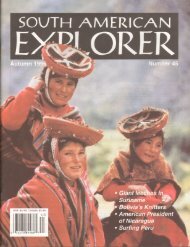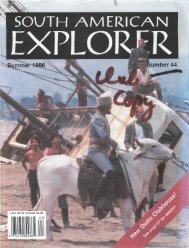Number 30 - South American Explorers
Number 30 - South American Explorers
Number 30 - South American Explorers
Create successful ePaper yourself
Turn your PDF publications into a flip-book with our unique Google optimized e-Paper software.
18 SOUTH AMERICAN EXPLORER<br />
bian display at the Denver Art Museum, the dialogue is<br />
ever the same: "But Teddy, pre-Colombian art is not<br />
beautiful." Whereupon, I marshal my arguments about<br />
symbolism and design until she concedes that some<br />
pieces are more attractive than others. On the other<br />
hand, perhaps I have just worn her down.<br />
Nancy is not alone. Many visitors to the museum<br />
find pre-Colombian art interesting, especially if they are<br />
told something about the people who produced it. But<br />
it's another matter when it comes to appreciating its<br />
artistic merit. "It's just so different." And, indeed, pre-<br />
Colombian art has a perceptibly "other" feeling than<br />
what we're familiar with from our European tradition.<br />
This is especially true with regard to the human body.<br />
We automatically compare everything we see with the<br />
form idealized by the Greeks and perpetuated by the<br />
Romans. It's an ingrained response by now, and not<br />
even the discovery at the turn of the century of African<br />
abstraction has done more than make a dent in our<br />
conditioning. Furthermore, it is hard for people to believe<br />
that artists working 2,000 years ago could have<br />
produced work that qualifies as world-class art.<br />
Pre-Colombian art exhibits have different<br />
objectives than those strived for in<br />
other museums. Standards of compositional<br />
harmony and high levels of design<br />
quality are paramount and govern<br />
the selection. At its best, pre-Colombian art possesses<br />
these qualities in great measure, but they take awhile to<br />
see. Some discernment is required and an effort must<br />
be made to trace the mobilization of elements, the use<br />
of curvilinear or straight-line repetitions, the rhythmical<br />
groupings of shapes and forms which together comprise<br />
the coherence of a piece. We must learn to see it, for the<br />
beauty is there, although couched in a new vocabulary<br />
of forms.<br />
The burial urn discussed previously is an example of<br />
a fine work; so is the exuberant lady in Figure Two with<br />
her mouth open in a round little "O." Notice how this<br />
round form, or parts of this form—small arcs, are repeated<br />
by the artist over and over again, appearing in<br />
the hemisphere of her headdress (one side is broken<br />
off) and echoed in the round of her skirt at the bottom.<br />
Created to be the lid on a burial urn, she's a two-sided<br />
lady, the same figure front and back. She doesn't look a<br />
bit funereal, does she? Could she be singing, chanting,<br />
or perhaps saying a prayer?<br />
The large nose plug worn by the little lady is fre<br />
quently encountered in pre-Colombian art, an indication<br />
of the enjoyment ancient <strong>American</strong> peoples took in<br />
all forms of jewelry and ornamentation. Elaborate hairstyles,<br />
large sweeping headdresses, and many different<br />
kinds of jewelry adorn the figurines. Often these diminutive<br />
people wear little clothing, but jewelry they parade<br />
in abundance, fashioned from bone, wood, colored<br />
stones, pearls, shell, antlers, claws, animal teeth, and, of<br />
course, where available, copper, gold, and silver. It's<br />
instructive to walk through a museum, noting the different<br />
ways the artists ornament their figures. Every<br />
type of jewelry we see today, and then some, is used:<br />
jewelry for the nose and lip, cheek ornaments as well as<br />
upper arm and leg bracelets, belts, and every variety of<br />
skin tattooing.<br />
Figure Three is a Popoyan warrior with a monkey on<br />
his back, sitting on a bench. (Only the males sit on<br />
benches in pre-Colombian art; the females sit on the<br />
ground.) The warrior is actually a container. Fie is holding<br />
a shield and wears a stunning necklace cast In gold.<br />
His headdress, a lid, comes off to reveal the hollow<br />
interior. This is a very rare sculptu re: there are only two<br />
or three examples like it in the world. The one at the<br />
Denver Art Museum is in the best condition. Ancient<br />
ceramics suffer greatly from ground pressures, movements<br />
of the earth and corrosive acids in ground water.<br />
It is common for archaeologists to find many broken<br />
pots, all together in heaps at the bottom of their excavations.<br />
The Popoyan warrior evidently emerged unscathed,<br />
something of a wonder in itself.<br />
The monkey on the back of the warrior puts this<br />
sculpture in a distinct class of human figures. These<br />
always have an animal companion or, as some scholars<br />
say, an "alter ago" on their backs. We don't know what<br />
is intended by the imagery, but contemporary Maya<br />
thought might hold a clue. According to Martin Prechtel,<br />
a Guatemalan shaman whom I met some years<br />
ago at a University of Colorado lecture, all humans<br />
have an animal spirit. When a person is out of harmony<br />
with his animal spirit he falls ill. In Guatemala, one may<br />
regain harmony through a shaman who can diagnose<br />
the difficulty and treat it by contacting the animal spirit..<br />
The imagery of the Popoyan warrior may encode<br />
another meaning altogether, of course. It may merely<br />
represent the insignia of a warrior group, but in any<br />
RIGHT, Popoyan effigy vessel, c. A.D. 1200, Middle<br />
Magdalena River Valley, Colombia. Denver Art Museum.





